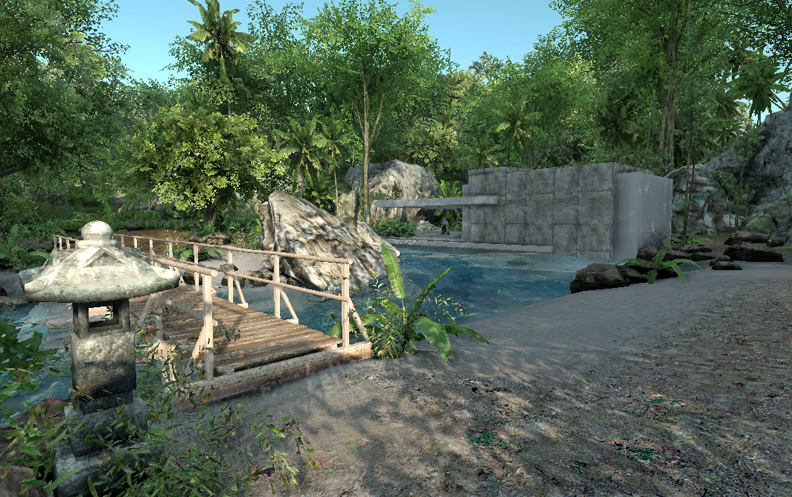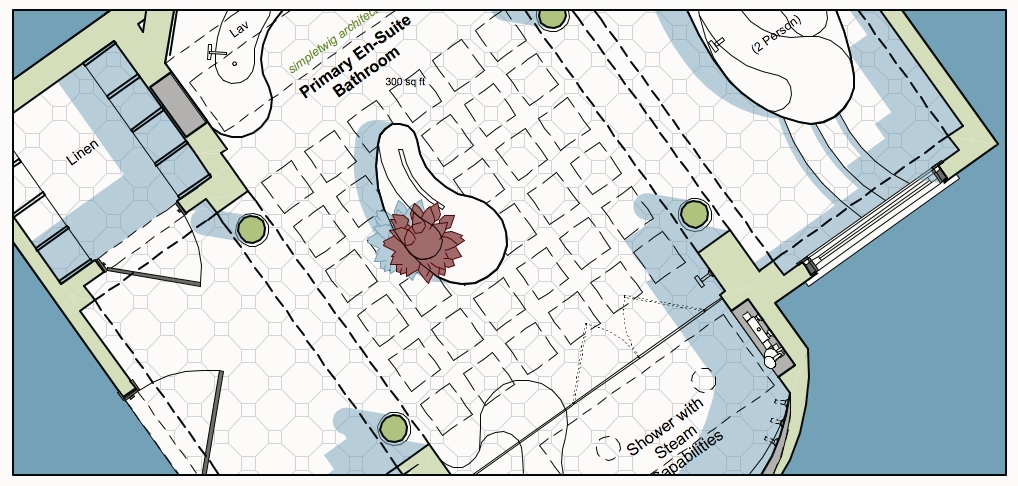GOALS:
- To create an ideal bathroom that retains the smallest practical footprint while meeting the adult requirements of living.
- Make a checklist of all the requirements needed in a modern bathroom.
- ‘Compare and Contrast’ 4 types of layouts, from the cheapest bathroom to a luxury layout, in order to understand the differences.
As a result of this analysis, we hope to determine the ideal bathroom for the majority of people, which can be used in all dwelling types. Dwelling types that include Studio/One-Bedroom apartments, or as the primary bathroom in multi-bedroom dwelling.
The following bathroom types, Type 1 through 4, along with an essential check list of features, provides a comprehensive analysis of Bathroom Design.
CONSIDERATIONS TO KEEP IN MIND WHEN CREATING A BATHROOM LAYOUT:
Complete Design: All elements of a project should be thought out and fully integrated to help the contractor complete the project with all upgrades without unnecessary delays. Delays can wreck havoc to a project and a contractor who discovers a problem that might required Department of Buildings’ approval will jeopardize everything. This includes lighting, plumbing, circulation, door swings and clearances, locations of switches, storage, and all those corners and details.
Area: While it is important to keep floor area to a minimum, circulation space should be ample for two people to maneuver (as well as accommodate a wheelchair). This includes access to a shower, tub and toilet area. A minimum width for passage is 4 feet.
Sinks: Sinks should have ample countertop area for ‘getting ready’ items, that can easily be put away to keep the bathroom looking tidy and making the countertop easy to keep clean. The only item left on a countertop is soap. Toothbrushes should be suspended from the wall, or put into a cubby.
Windows: Windows should be positioned to provide privacy, for light and for fresh air, to meet code requirements. A bathroom window is not an fire egress window there is flexibility with its placement. A skylight is a good substitute for a window, if it is operable and fully insulated.
LINEN CLOSET AND STORAGE
All homes and apartments, no matter the size, require a linen closet to store towels and toiletries. The question one must ask, ‘is it better to have it in the bathroom where the items will be used, or have it in the hallway where the door will take up wall space (for pictures) and as such will be mixed with other household items.
The shelves should be at least 1′-2″ deep and at least 2′-6″ wide. Ideally they would be 1′-6″ deep x 3′-6″ wide in order to have space for a proper door.
Since we are focused on function and efficiency, our conclusion is to have the linen closet in the bathroom where it will store the items used by the function of that room. Combined with a lower pull-out drawl for cleaning supplies, the closet will conveniently store all those extra items out-of-sight but within reach.
In hallway accessible closets sheets and blankets can be stored, but in this case I believe these too should be stored where they are used, in the bedroom.
OTHER CONSIDERATIONS
Plumbing: The shower and toilet have floor drains, because it is better to keep these two fixtures closer together to limit the distance to the stack (sewer line and vent to roof line).
While the bathroom is one area that requires plumbing, it is more economical to keep the kitchen and laundry close, freeing up more of the budget for other parts of the home. Grouping rough-in plumbing costs less to build and helps expedite the construction time-table. All time saved can ease the ‘time for construction’, helping the designer and contractor ensure the successful completion of the project. The lavatory, whose rough-in plumbing can run through wall studs, is easier to move to a separated location. On high-end or luxury projects grouping isn’t a concern.
LAUNDRY: Sometimes the laundry is placed within the bathroom, because of the ease of access to rough-in plumbing, but it is a functional room onto itself and is thus not acceptable to have it in the bathroom for several reasons, including noise, cleanliness and wall space. Ultimately having laundry within the bathroom turns the bathroom into a utility room which is definitely not acceptable.
BATHROOM TYPE 1
TYPE 1: CHEAPEST BASIC BATHROOM:
We start our compare/contrast analysis with the most common type of bathroom in the United States. A significant upgrade from what was normal before the 1940’s, today it is inadequate and is the subject of many renovations.
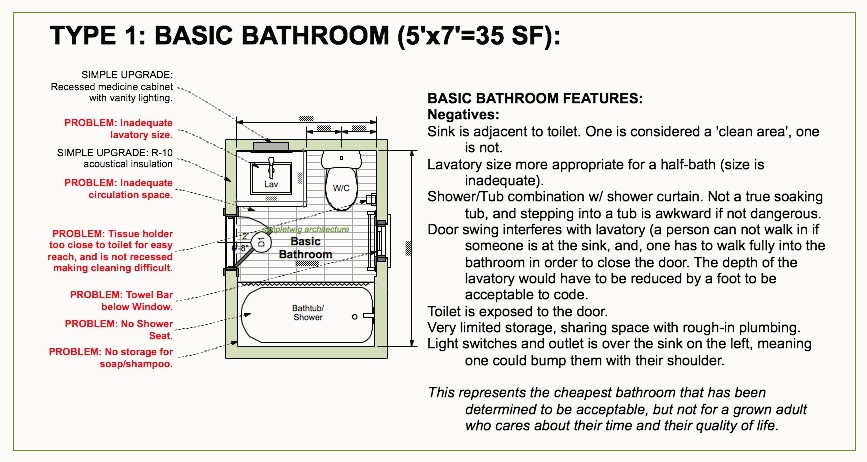
FIXTURES:
- Sink;
- Tub/Shower;
- Toilet (1′-3″ clear from centerline);
WALLS/FLOORS/CEILING:
- Tile Floor (non-slip);
- Tub Enclosure plus painted sheetrock (eggshell walls/trim, flat ceiling);
ACCESSORIES:
- Mirror;
- Toilet Tissue Holder;
- Towel Rack,
- Shower Curtain;
- Window for ventilation or 40 to 60 cfm fan/vent to exterior;
- Heat/Radiator;
While the above fulfills the definition of a bathroom, it lacks in several functions required for a typical adult: it requires the user to store items elsewhere in the home, it is harder to clean which requires more time, it isn’t a relaxing space, and it doesn’t accommodate safety features that could prevent serious injury, it is cramped providing only minimal space, and it certainly isn’t a space we are proud to show off.
Most of today’s bathrooms incorporate some of the following ‘Simple Upgrades.’
SIMPLE UPGRADES FOR THE BASIC TYPE 1 BATHROOM
- Sink with additional countertop space and storage below: At least one pull-out drawer and space for extra rolls of TP and other bathing items. The more storage space provided the cleaner the countertop will remain.
- Recessed medicine cabinet with mirror: Prevents shadow on wall helping to make bathroom feel larger (than if mounted on surface) and provides extra storage for small items.
- Door Threshold: To block flooding, and to transition between flooring materials.
- Vanity Lighting: To help illuminate the face.
- Additional Circulation Space: Easier to maneuver.
- Tile around Toilet: To keep area clean and sanitary.
- Backsplash at Sink: Easier cleaning.
- Shower Storage: Shelving for soap, shampoo, etc. A place to hold wash cloths. Hook to hold loofah scrubber.
These simple upgrades are the most common, and represent an acknowledgement of the functional need for these additions. Beyond these ‘Simple Upgrades’ we really need to address ‘Quality Upgrades’ that most adults would welcome, and how they would influence a bathroom layout.
QUALITY UPGRADE OPTIONS
To make our bathroom fully functional and beautiful, we will need some features. Here’s a list. Did we forget anything?
UPGRADES WITH EASE OF CLEANING IN MIND:
Floating Sink and Toilet; This keep fixtures from touching the floor, allowing us to easily clean it whenever required. It also prevents dark areas on the tile and grout, those places a mop just can’t throughly reach and clean.
Rounded tile baseboard in corners; This helps keep the corner clean.
Large format tile in shower and on floor; This reduces the amount of grout, as long as the floor remains slip resistant. Grout, if not sealed, will absorb water which helps prevent slips, but most people want to seal the grout to prevent staining. Polished marble, while looking great, is a no-no in wet areas as it offers no traction. A better option is limestone or travertine which can absorb some moisture and has some traction qualities. Ultimately, reducing the amount of grout makes keeping the bathroom clean a lot easier, providing less porous surfaces for mold to take hold.
To truly be function, thus saving time, ease of cleaning is a must. As such, the sink should be easy to wipe down without moving items around, and the floor should be unencumbered with fixtures and cabinets, and there should be an effort to reduce the amount of grout in all areas.
UPGRADES WITH STORAGE IN MIND
Additional towel bars/hooks, especially hand towel at sink area; Linen Closet to store towels, extra tissue products, basic cleaning supplies; Open Towel Shelf; Potpourri or Flower niche; Hook for Bathrobe.
Easy to access sink storage must accommodate: Mouth Wash bottle; Water Pick; Sonic Tooth Brush; Razor; Electric Shaver; Tweezers; Nail Clippers; Scissors; Soap (typically left on sink countertop); Makeup (organized in a drawer); Lotions; Facial Cleaners; Tooth Paste; Dental Floss;
Other moderately easy to access storage must accommodate: Paper Towels; Extra Toilet Tissue (8 rolls); Bandaids (Aid Box); Q-tips; Extra Liquid & Bar Soap; Extra Shampoo/Conditioner; Extra Towels; Trash Can;
Less frequently accessed items include: Cleaning Supplies (toilet cleaner, general purpose spray, powder cleaner, glass cleaner); Toilet Brush; Sponge or other scrubber; Paper Towels for Cleaning;
Ideally cleaning supplies would be in a pull out drawer below a linen closet and not part of a vanity, i.e. hidden, easy to access and contained by themselves. The drawer, open on the sides, could have a top shelf for small items and lower containment shelf for bulky things.
UPGRADES WITH SAFETY/ACCESSIBILITY IN MIND
Grab Bars in Tub/Shower area; Curb-less Shower; 2′-10″ door; Shower Seat; Shower Controls next to Shower Door (not under shower head).
With the above upgrades in mind, we shall explore Type 2 Bathroom, one that is made for adults but is still mindful of floor area.
TYPE 2: IDEAL ADULT SIZED BATHROOM
Incorporating all the upgrades above, and adding additional qualities, we come up with the following plan. Type 2 is in our mind what all primary bathrooms should attempt to achieve.
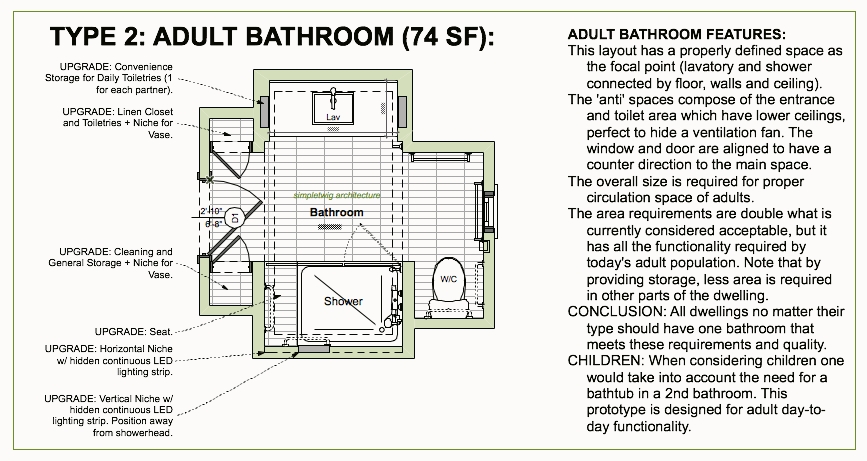
UPGRADES WITH QUALITY OF ATMOSPHERE AND FUNCTIONALITY IN MIND:
The H
- Special window/skylight;
- Recessed LED cove lighting and Accent Lights;
- Mirror Lighting (recessed for general atmosphere);
- Recessed Toilet Tissue Holder;
- Acoustical insulation around all walls;
- Along with window, 40 to 60 cfm fan/vent to exterior w/ recessed grill, or hidden vent in soffit;
- Handheld shower head;
- Vanity drawers (with dividers/organizers) and recess/pullout for trash can;
- Separate vanity storage cabinet (other than medicine cabinet) to store tooth brushes, razors, etc. so mirror can remain independent.
- Feature tile wall (different color);
- Ample floor area for ease of circulation;
- Quality Outlets, Switches and Lighting Fixtures;
- Full Length Mirror;
- Scale Storage;
- Trash Can Storage;
TYPE 3 HIGH-END BATHROOM
The High-End Bathroom requires and additional 63 square feet, almost doubling the size of Type 2 bathroom. This type is for those with a budget and the space to accommodate the space requirements.
Electric Radiant Floor Heating for use in Bathrooms is fast becoming an acceptable alternative to a free-standing radiator. Radiators take up room, look ugly (usually) and collect dust, so under floor heating solves many issues and is worth incorporating into one’s bathroom design.
- Soaking Tub with separate Shower;
- Two Sinks;
- Separate Linen and Cleaning Cabinets/Closets;
- Larger Toilet Nook;
- 2 Person Shower with Seat, Glass Enclosure and Additional Shower Features;
- Picture Window and Skylight(s);
- Towel Warming Island;
- Radiant Floor Heating (optional for Type 2 as well);
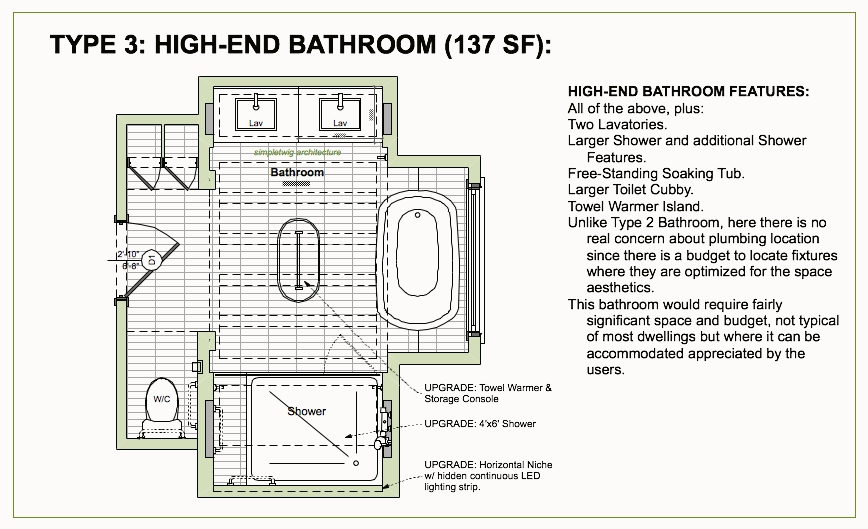
Shower Glass Partition versus Shower Curtain. Glass looks better period, but does have cleaning challenges. Partitions and shower doors should be frameless to help keep it clean. Special attention to door swings, connections and backing, use of tempered glass w/ ‘clean surface’ properties should help keep glass looking great between periodic cleanings. The alternative for a walk-in curbless shower is no partition, but this has two main downsides: 1) it will feel cold when you shower (as hot air from hot water rises it will pull in cool air into your shower) and 2) it will get the bathroom wet (and potentially slippery).
TYPE 4 LUXURY BATHROOM:
The Luxury Bathroom is complete in every way. It’s challenge, because it is so large, is to keep everything in proportion so that architecturally it feels natural and inviting. Features include all of the items for Type 3 above, plus:
- Custom Sink, mirrors and vanity storage;
- Full walk-in Linen Closet;
- Towel Island w/ Built-in Seating;
- Two person Bathtub with surrounding picture windows and skylights;
- Custom Shower for Two with built-in seating and walls, spray nozzles, rain shower heads, and all the bells and whistles including a steam shower;
- Separate Toilet Room with its own lavatory, mirror and bidet.
- Radiant Heated Floors and Furniture;
- Central Vacuum System;
While some may call these necessities, they are luxuries due to their cost and fundamental need.
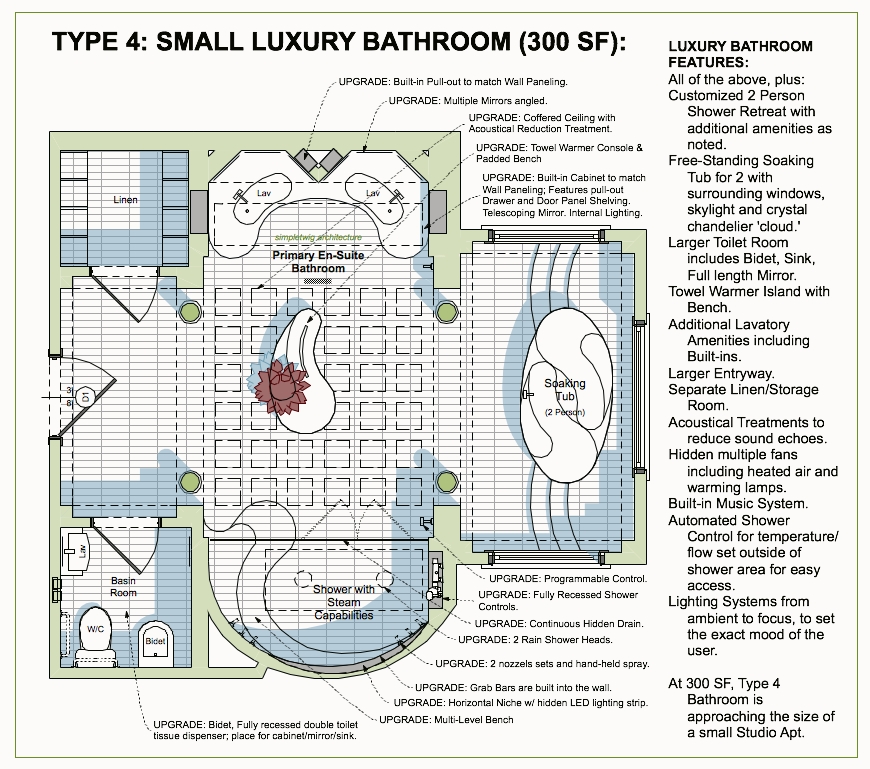
Two Sinks plus hidden cabinetry, multiple angle mirrors, custom sinks/countertop; Toilet room has bidet, separate sink, etc.
If you’re going for a really spectacular luxury bathroom, add a fire-place feature to achieve the ultimate relaxing atmosphere while enjoying bathing in your tub with a view!
LIGHTING
A note about lighting:
- A single fixture on the ceiling is not the thing to do. It will leave the bathroom washed out and dull, while creating shadows that will never see light. It is better to have a minimum of two general recessed down-lights to help wash the walls and get all parts of the bathroom lit.
- Vanity lighting is a must for normal daily preparation.
- Upgrade: install on at least one wall indirect diffused continuous lighting. This will provide reflected light which becomes the backdrop for other lighting, helping make the bathroom bright without undermining the atmosphere. One could choose cove lighting, or perimeter mirror light as examples. For proper diffusion using continuous LED lights, one must install a plastic diffuser strip.
- Further upgrades integrates additional continuous lighting strips, especially in the shower and around the bathroom. This might include under cabinet lighting to help illuminate the floor.
- Dimmer Switches help adjust the lighting to suit one’s mood.
- Since shadows are the enemy of a well-lit space, avoid projecting shelves and cabinetry. It is better to recess these elements or provide lighting to counteract their shadows.
ACCESSORY DESIGN ELEMENTS
- NICHE: So you’ve planned out a perfect bathroom, but did you provide room for that special touch? Lowering the height of a wall cabinet one can provide a cubby for a plant, vase with flowers or a bowl with potpourri. This simple gesture can help make the functionality of using the bathroom feel more enjoyable.
- READING MATERIAL: Yes this is sometimes a bonus feature that many people enjoy. Along with a place for magazines, books and newspapers might be a recessed shelf.
- RADIANT LAMP: This to keep warm and help to dry off.
- USED TOWEL RECEPTACLE: A laundry chute to get rid of wet towels.
- CENTRALIZED VACUUM SYSTEM: It is much quieter to vacuum if one doesn’t need to haul around the vacuum machine.
- GRAB BARS: Shown in plan as dashed lines around the toilet and in the shower stall.
- FULLY ADA COMPLIANT: All modern bathrooms should be able to convert to fully handicap accessible facilities, i.e. to make fully adaptable. This means that the door should have a minimum of 2′-10″ clearance, there should be enough room to turn around (5′-0″ diameter) and that the lavatory is wide enough and the rough-in plumbing doesn’t impede on the knees of a wheelchair bound individual. Further all hardware must be lever handles. Other features are possible including self-opening/closing doors and other items.
Did we miss anything? What did you like and what would you add to your dream bathroom?
For a past article where we explore variations of materials for an Apartment Building bathrooms, see http://www.simpletwig.com/blog/new-residential-development-in-brooklyn-bathroom-themes/#more-1986
